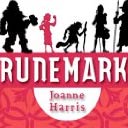Runemarks by Joanne Harris is fantasy with a strong base in Norse mythology. The book is set five hundred years after Ragnarók, the Norse battle bringing the end of the worlds. The general idea is that the Norse gods, known as the Æsir, lost the battle, and another took over, calling himself The Nameless, as names have power and can be used against their owner. The Nameless, as the book later tells, is someone who was not one of the Æsir, but someone who was known to them pre-Ragnarók
The resulting nine worlds are filled with anti-magic propoganda and a restrictive organization that enforces the laws set down by The Nameless and attempts to exterminate any of the Æsir, Faëries, etc., that they can find.
In the small village of Malbry a young girl, named Maddy, is found by a one-eyed traveller. He notes the runemark, which denotes that the bearer can wield runic powers, and begins to teach her magic, returning to the village every year to do so.
The final time One-Eye comes to Malbry, he talks to Maddy about an item he simply called “The Whisperer,” and mentions to be of great power. He sends Maddy through a portal to the World Below to find it, where she runs into the trickster god Loki, who tells her more of The Whisperer (revealing it to be Mimir the Oracle), and agrees to help her obtain it, though he at first seemed to be plotting to take it for himself.
From there the sprawling plotline unfolds. The Vanir are woken from their 500-year-long sleep, Maddy and Loki try to break some of the Æsir from the Underworld on the advice of the Oracle, and a few prophecies are made of an impending battle, another Ragnarók. Eventually it is revealed who The Nameless is, who the prohesied traitor among the Æsir is, and just how important Maddy is in the scheme of things.
I really enjoyed Runemarks. It’s enjoyable and fairly long; the story is fresh, with good characters, yet it feels very Norse. The mechanics of the magic are interesting as well. The characters cast various runes to get the end result they want, which I assume is based off the idea of casting stones etched with runic symbols in effort to divine the future (which is generally thought to be of Norse origin).
Again, Runemarks is worth a read if you can get your hands on a copy.





Add Yours
YOU